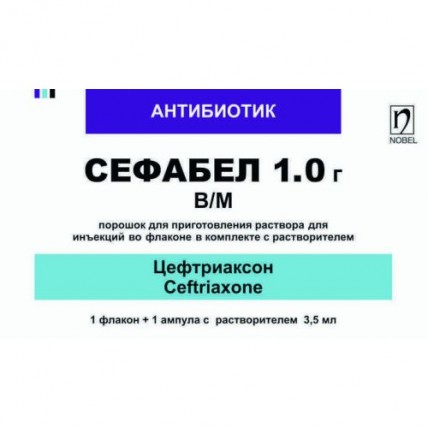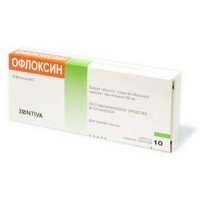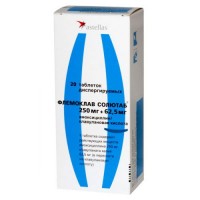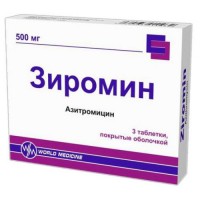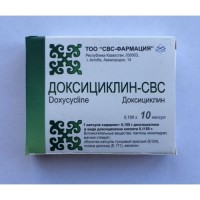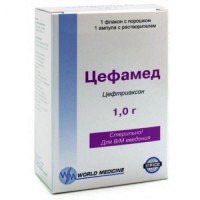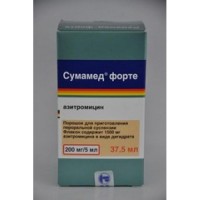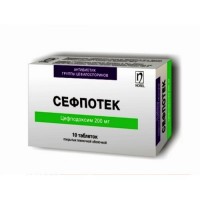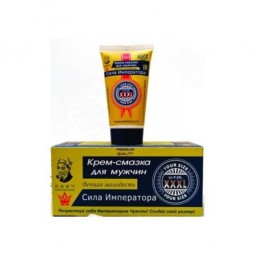Sefabel 1g of sol. 3.5 ml of a 1% solution of lidocaine powder for injection / m
- $8.80
The instruction for medical use of Sefabel Torgovoye medicine a name Sefabel Mezhdunarodnoye the unlicensed name Tseftriakson Lekarstvennaya a form Powder for preparation of solution for intramuscular injections of 0.5 g and 1.0 g complete with solvent (1% hydrochloride lidocaine solution for injections of 2 ml and 3.5 ml) Structure One bottle contains active agent - sodium of a tseftriakson trihydrate of 608.38 mg or 1216.77 mg (it is equivalent to a tseftriakson of 510 mg or 1020 mg) Solvent: one ampoule contains active agent – hydrochloride lidocaine monohydrate of 21.4 mg or 37.45 mg (it is equivalent to lidocaine to a hydrochloride of 20 mg or 35 mg), excipient: water for injections. Description Crystal powder of almost white or yellowish color, slightly hydroscopic. Solvent: transparent colourless solution. Pharmacotherapeutic group Antibacterial drugs for system use. Beta laktamnye antibacterial drugs other. Cephalosporins of the third generation. Tseftriakson. The ATX J01DD04 code the Pharmacological Pharmacokinetics Later properties of intravenous bolyusny administration of a tseftriakson of 500 mg and 1 g, the average level of a tseftriakson in plasma was about 120 and 200 mg/l respectively. After intravenous bolyusny administration of a tseftriakson of 500 mg, 1 g and 2 g, the average level of a tseftriakson in plasma was about 80, 150 and 250 mg/l respectively. After intramuscular introduction the average levels of a tseftriakson in plasma were approximately twice less, than what was observed after intravenous administration of an equivalent dose. The maximum concentration in blood plasma after a single intramuscular dose of 1 g made about 81 mg/l which was reached within 2 - 3 hours after introduction. The area under a dependence curve 'concentration time' after intramuscular introduction was the same that was after intravenous administration of an equivalent dose. The volume of distribution of a tseftriakson was equal to 7 - 12 l. Concentration which much more the minimum inhibiting concentration of the majority of the corresponding pathogens, can be found in fabrics, including lungs, heart, bilious ways / a liver, a tonsil, a middle ear and a mucous membrane of a nose, a bone and also in cerebrospinal, pleural, prostatic and synovial fluid. 8 - 15% increase in average peak concentration in plasma (Cmax) were observed at repeated introduction, the Equilibrium state was reached in the majority cases within 48 - 72 hours depending on a way of administration of drug. Tseftriakson gets into a brain cover. When the cover of a brain inflames, penetration becomes maximum. Average peak concentration of a tseftriakson in cerebrospinal fluid at patients with bacterial meningitis are noted in reports, made up to 25% of concentration in plasma in comparison with 2% of concentration in plasma at patients with the inflamed brain cover. Peak concentration of a tseftriakson in cerebrospinal fluid is reached approximately in 4-6 hours after intravenous administration. Tseftriakson gets through a placental barrier and is allocated in breast milk in low concentration. Tseftriakson reversibly contacts albumine. Linking with proteins of plasma makes about 95% at concentration in plasma lower than 100 mg/l. Binding is saturable and the connected part decreases with concentration growth (up to 85% at concentration in plasma 300mg/l). Tseftriakson systemically is not metabolized, and turns into inactive metabolites under the influence of indestinal flora. The plasma clearance of the general tseftriakson (connected and untied) is 10 - 22 ml/min. The renal clearance is 5 - 12 ml/min. of 50 - 60% of a tseftriakson is brought out of an organism in not changed look together with urine, generally by glomerular filtration in kidneys, and 40 - 50% are brought out of an organism in not changed view with bile. Elimination half-life of the general tseftriakson at adults makes about 8 hours of an organism. Patients with a renal and liver failure At patients with a renal and liver failure the pharmacokinetics of a tseftriakson changes only minimum with small increase in elimination half-life (less than twice), even at patients with a heavy renal failure. Rather small increase in elimination half-life in a renal failure is explained by the compensating increase in not renal clearance that leads to decrease in binding of protein and the corresponding increase in not renal clearance of the general tseftriakson. At patients with a liver failure, biological half-life does not increase because of the compensating increase in renal clearance. It is also connected with increase tseftriakson without fraction of plasma that promotes observed paradoxical increase in the general clearance of drug and also increase in volume of distribution in parallel with the general clearance. People of advanced age At elderly people are aged more senior than 75 years average elimination half-life, usually, two-three times more, than teenagers. Children Elimination half-life of a tseftriakson increases at newborns. At children aged from just rodivishikhsya up to 14 days, the level of a free tseftriakson can be also increased because of such factors as decrease in glomerular filtration and change of protein-binding. At children, elimination half-life is less than at novrozhdenny or adult. The plasma clearance and volume of distribution of the general tseftriakson are more at newborns, babies and children, than at adults. Linearity / nonlinearity Pharmacokinetics of a tseftriakson are nonlinear, and all key pharmacokinetic parameters, except for elimination half-life, depend on a dose if they are based on the general concentration of drug and increased less than in proportion to a dose. Nonlinearity is caused by saturation of linking with proteins of plasma and therefore it is observed at the general tseftriakson in plasma, but not at free (untied) to the tseftriaksena. Communication between pharmacokinetics and a pharmacodynamics Also as well as other beta lactams, pharmacokinetic pharmakodinamichesky indicators show the best compatibility with efficiency in a living organism, the being percent of an interval between administrations of drug so untied concentration remains higher than the minimum inhibiting concentration (MIC) of a tseftriakson for some studied types (i.e. % of T & gt, MIK). The pharmacodynamics Tseftriakson suppresses synthesis of a bacterial cell wall after attachment to penicillin - to the connecting proteins (PBP). It leads to interruption of biosynthesis of a cell wall (peptidoglikan) that leads to lysis of bacterial cells and death. Resistance of bacteria to a tseftriakson can be connected with one or several of the following mechanisms: • hydrolysis beta laktamaz, including beta laktamaz an expanded range (ESBL), karbapenemaz and enzymes of Amp of C which can be induced or steadily be suppressed at certain aerobic gram-negative species of bacteria • penicillin - the connecting proteins for a tseftriakson reduces affinity • impermeability of an outer membrane at gram-negative microorganisms. • bacterial effluxny pumps the Control points of the minimum inhibiting concentration (MIS) established by the European committee on testing of Antimicrobic sensitivity (EUCAST) are following: Pathogenic microorganism Test of dilution (MIC, mg/l) Sensitive Resistant Enterobacteriaceae ≤ 1 & gt, 2 Vida Staphylococcus and. and. types of Streptococcus (A, B, C groups and G) b. b. Streptococcus pneumoniae ≤ 0.5 with & gt, the 2nd Streptococci Viridans ≤0.5 & gt group, 0.5 Haemophilus influenzae ≤ 0.12s & gt, 0.12 Moraxella catarrhalis ≤ 1 & gt, 2 Neisseria gonorrhoeae ≤ 0.12 & gt, 0.12 Neisseria meningitidis ≤ 0.12 with & gt, 0.12 Nevidospetsifichno of 1 d & gt connected ≤, 2 and. - The sensitivity comes from sensitivity of a tsefoksitin. b. - The sensitivity comes from sensitivity of penicillin. page. - Isolates with MIC of a tseftriakson over a point of sensitivity are rare and if they are found, has to be tested repeatedly and if they are confirmed, they should be sent to reference laboratory. d. - Control points are applied to a daily intravenous dose of 1 g x 1 and a high dose of at least 2 g x 1. Clinical performance against specific pathogens can geographically vary Prevalence of the acquired resistance also on time for the chosen types and it is desirable to have local information on resistance, especially at treatment of heavy infections. If necessary it is necessary to consult with the expert if local prevalence of resistance such is that the usefulness of a tseftriakson, at least, against some types of infections raises doubts. Susceptible species of bacteria: Gram-positive aerobes - golden staphylococcus (Methicillinum - sensitive), staphylococcus koagulazonegativny (Methicillinum - sensitive), a piogenic streptococcus (group A), a streptococcus of an agalakti (group B), a pneumonia streptococcus, a viridans group streptococcus Gram-negative aerobes - Borrelia burgdorferi, a hemophilic stick, Haemophilus parainfluenzae, a moraksella katarralis, gonokokk, meningokokk, a bacterium Proteus a false jalap, Providencia spp., a pale treponema of Vida for which the acquired rezistentost can cause serious problems: Gram-positive aerobes - epidermal staphylococcus, hemolytic staphylococcus, staphylococcus hominis Gram-negative aerobes - a tsitrobakter of a freunda, an enterobakter aerogenes, an enterobakter of a foul place, colibacillus, a klebsiyella of pneumonia, a klebsiyell of oxycurrent, Morganella morganii, vulgar proteas, a serration martsestsens Anaerobe bacterias – bacteroids, fuzobakteriya, peptostreptokokk, an enteritny clostridium Hereditarily resistant organisms: Gram-positive aerobes – enterokokk, a listeriya monocytogenic Gram-negative aerobes - Baumann's akinetobakteriya, a pyocyanic stick, Stenotrophomonas maltophilia Anaerobe bacterias - klostridium to a diffitsila Other – a chlamydia, Chlamydophila spp., a mycoplasma, legionella, Ureaplasma urealyticum All Methicillinum - sensitive staphylococcus are resistant to a tseftriakson. Indications Sefabel is shown for treatment of the following infections at adults and children, including the full-term newborns: - bacterial meningitis - community-acquired pneumonia - intrahospital pneumonia - acute average otitis - intraabdominal infections - the complicated infections of urinary tract (including pyelonephritis) - infections of bones and joints - difficult infections of skin and soft tissues - gonorrhea - syphilis - a bacterial endocarditis - acute exacerbations of a chronic obstructive pulmonary disease at adults - Lyme's disease (early and late stage) at adults and children, including newborn children from 15-day age - the neutropenia and fever caused by a bacterial infection - preoperative prevention of surgical infections the Route of administration and doses Sefabel is intended for intramuscular use. The solution containing lidocaine cannot be entered intravenously! The dose depends on weight, sensitivity, localization and like an infection and also on age and hepatonephric function of the patient. The doses recommended in tables below are the general recommended doses according to these indications. In especially hard cases it is possible to consider doses of higher border of the recommended range. Duration of treatment depends on a course of the disease. As well as in case of therapy by antibiotics in general introduction of a tseftriakson should be continued within 48 - 72 hours after the patient became afebrilny, or the evidence of an eradikation is obtained. Adults and children are more senior than 12 years (≥ 50 kg): A dosage of a tseftriakson * treatment Frequency ** Indications of 1 - 2 g of Times a day Community-acquired pneumonia, exacerbation of a chronic obstructive pulmonary disease, intraabdominal infections, the complicated infections of urinary tract (including. pyelonephritis) 2 g of Times a day Intrahospital pneumonia, the complicated infections of skin and soft tissues, infections of bones and joints of 2 - 4 g of Times a day Treatment of patients with a neutropenia and fever caused by a bacterial infection, a bacterial endocarditis, bacterial meningitis * At the registered bacteremia it is necessary to consider an upper limit of the recommended range of doses ** Introduction twice a day (each 12 hours) it is possible to consider where doses more, than 2 g a day are entered. Indications for adults and children are more senior than 12 years (≥ 50 kg) which demand specific schedules of dosing: In acute average otitis enter a single intramuscular dose Sefabel of 1 - 2 g. Limited data demonstrate that when the patient is seriously ill or the previous therapy was unsuccessful, Sefabel can be effective at intramuscular introduction in a dose of 1 - 2 g a day during 3 - x days. For preoperative prevention of surgical infections drug is appointed on 2 g in the form of one preoperative dose in 30 - 90 minutes prior to operation. Gonorrhea the Recommended dose makes 500 mg in the form of a single intramuscular injection. Syphilis the Recommended dose makes 500 mg - 1 g with increase in a dose to 2 g in case of neurosyphilis within 10-14 days once a day once a day. Lyme's disease (early and late stage) the Recommended dose makes 2 g within 14-21 days once a day. Pediatric population Newborns and children from 15 days to 12 years (& lt, 50 kg) For children with the body weight of 50 kg or more should appoint a usual dose for adults. A dosage of a tseftriakson * treatment Frequency ** Indications of 50 - 80 mg/kg of Times a day Intraabdominal infections, the Complicated infections of urinary tract (including pyelonephritis), extra hospital pneumonia, intrahospital pneumonia of 50 - 100 mg/kg (max. 4 g) of Times a day the Complicated infections of skin and soft tissues, infections of bones and joints, treatment of patients with the neutropenia and fever which arose presumably because of a bacterial infection of 80 - 100 mg/kg (max. 4 g) of Times a day Bacterial meningitis of 100 mg/g (max. 4 g) of Times a day the Bacterial endocarditis * At the registered bacteremia it is necessary to consider an upper limit of the recommended range of doses. ** Introduction twice a day (each 12 hours) can be considered where doses more, than 2 g a day are entered. Indications for newborns, babies and children from 15 days to 12 years (& lt, 50 kg) who demand the specific schedule of dosing: Acute average otitis For initial treatment of acute average otitis, it is possible to enter a single intramuscular dose Sefabel of 50 mg/kg. Limited data demonstrate that when the child is seriously ill or initial therapy was not successful, Sefabel can be effective at introduction in the form of an intramuscular dose of 50 mg/kg daily during 3 – x days. For preoperative prevention of surgical infections drug is appointed on 50-80 mg/kg in the form of a single preoperative dose in 30 - 90 minutes prior to operation. Syphilis the Recommended dose is made by 75 - 100 mg/kg (no more than 4 g) once a day within 10-14 days. Lyme's disease (early and late stage) the Recommended dose makes 50 - 80 mg/kg within 14-21 days once a day. Newborns of 0-14 days Sefabel is contraindicated to premature newborn children. A dosage of a tseftriakson * treatment Frequency ** Indications of 20 - 50 mg/kg of Times a day Intraabdominal infections, the complicated infections of skin and soft tissues, the complicated infections of urinary tract (including pyelonephritis), community-acquired pneumonia, intrahospital pneumonia, infections of bones and joints, treatment of patients with the neutropenia and fever which arose presumably because of a bacterial infection of 50 mg/kg of Times a day Bacterial meningitis, a bacterial endocarditis. * At the registered bacteremia it is necessary to consider an upper limit of the recommended range of doses. The maximum daily dose of 50 mg/kg should not be exceeded. Indications for newborns of 0 - 14 days which demand specific schedules of dosing: Acute average otitis For initial treatment of acute average otitis, it is possible to enter a single intramuscular dose of Sefabel of 50 mg/kg. For preoperative prevention of surgical infections drug is appointed on 20 - 50 mg/kg in the form of a single preoperative dose in 30 - 90 minutes prior to operation. Syphilis the Recommended dose makes 50 mg/kg within 10 - 14 days once a day. The elderly Doses recommended for vzro
ly do not demand any changes for elderly people provided that they have satisfactory functions of kidneys and a liver. Patients with an abnormal liver function the Available data do not indicate the need to dose adjustment in a slight or moderate abnormal liver function provided that renal function is not broken. There are no these researches of patients with a heavy liver failure. Patients with a renal failure the patients with impaired renal function have no need to reduce a dose of a tseftriakson provided that function of a liver is not broken. Only in cases of a preterminal renal failure (clearance of creatinine & lt, 10 ml/min.) the dose of a tseftriakson should not exceed 2 g a day. No additional dosing is required from the patients who are on dialysis after dialysis. Tseftriakson is not brought by peritoneal dialysis or a hemodialysis. Clinical control of safety and efficiency is recommended. Patients with heavy hepatic and renal disturbances For patients with heavy renal and hepatic dysfunction the clinical control of safety and efficiency is recommended. Side effects Often (≥ 1/100 - & lt, 1/10) - an eosinophilia, a leukopenia, thrombocytopenia - diarrhea - rash, an acute anaphylaxis, anaphylactic reaction, hypersensitivity - increase in liver enzymes Infrequently (≥ 1/1000 - & lt, 1/100) - genital fungus infectious diseases - disorders of blood and lymphatic system (granulocytopenia, anemia, a coagulopathy) - a headache, dizziness - nausea, vomiting - an itching - phlebitis, pain in the place of an injection, the feverish state - growth of level of creatinine in blood is rare (≥ 1/10000 - & lt, 1/1000) - pseudomembranous colitis - a bronchospasm - rash (urticaria), an itching, hypostases, a fever - a hamaturia, a glucosuria Is unknown (it is impossible to estimate on the available data) - consecutive infection - hemolytic anemia, an agranulocytosis - spasms, dizziness, vertigo - pancreatitis, stomatitis, a glossitis - gepatobiliarny disorders (precipitated calcium superphosphates in a gall bladder, a kernicterus) - renal and uric disorders (an oliguria, renal precipitated calcium superphosphate (reversible)) - disturbances of skin and hypodermic fabrics (Stephens-Johnson's syndrome, a toxic epidermal necrolysis, an erythema multiformny, sharp generalized exanthematous pustulez) - false positive test results of Koombs, the test for a galactosemia and a non-enzymatic method of definition of glucose of the Contraindication - hypersensitivity to a tseftriakson, any other cephalosporins, on any other type beta laktamnykh antibacterial agents (penicillin, monobaktama and karbapenema) or to any of excipients - hypersensitivity to lidocaine - premature newborns to age 41 weeks (gestational age + chronological age) - the full-term newborns (up to 28 days of life): a) in the presence of a hyperbilirubinemia, jaundice, a hypoalbuminemia or acidosis, states at which disturbance of binding of bilirubin b) is possible if they need (or can be required) intravenous administration of calcium or calciferous solutions because of risk of formation of precipitated calcium superphosphates of calcic salt of a tseftriakson. - lidokainsoderzhashchy solutions cannot be entered intravenously - lidocaine is forbidden as solvent at children's and teenage age Medicinal interactions the Calcium-containing solvents, such as Ringera solution or Gartman's solution, it is not necessary to use for dissolution of contents of ampoules Sefabel as the deposit can be formed. Precipitation of tseftriaksona-calcium can be also formed if tseftriakson mixes up about calcium - the containing solution in the same system of intravenous administration. Tseftriakson it is not necessary to enter along with intravenous solutions, calciferous, including continuous calcium - the containing infusions, such as parenteral nutrition through a Y-tip. However patients, except newborns, tseftriakson and calcium - the containing solutions can enter consistently one after another if carefully to wash out infusional systems between infusions by the corresponding liquids. In the research in vitro of plasma of adults and plasmas of newborns from umbilical blood showed that at newborns the increased risk of sedimentation of tseftriaksona-calcium is observed. Therefore, tseftriakson and calcium - the containing solutions should not mix up or be entered at the same time. Simultaneous use with oral anticoagulants can increase effect of antivitamin K and risk of bleeding. Frequent control of the International Normalized ratio (INR) and a dosage antivitamin of the K-drugs modified as appropriate both in time, and after treatment tseftriaksony is recommended. There are contradictory data on potential increase in renal toxicity of aminoglycosides when they are used with cephalosporins. In such cases it is necessary to adhere to strictly recommended level of monitoring of aminoglycosides (and functions of kidneys) in clinical practice. In the research in vitro antagonistic effects at a combination of chloramphenicol and a tseftriakson were observed. The clinical importance of this conclusion is unknown. There were no messages about interaction between tseftriaksony and peroral calcium - the containing drugs or interaction between an intramuscular tseftriakson and calcium - the containing drugs (intravenous or peroral). At the patients receiving tseftriakson Koombs's test can result in false positive results. Tseftriakson, as well as other antibiotics, can cause false positive results of tests for a galactosemia. Similarly non-enzymatic methods of definition of glucose in urine can yield false positive results. Therefore determination of level of glucose in urine during therapy tseftriaksony should be carried out by an enzymatic method. Deterioration in function of kidneys after simultaneous use of high doses of a tseftriakson and strong diuretics was not observed (for example, furosemide). Simultaneous introduction of a probenetsid does not reduce elimination of a tseftriakson. Special indications of Reaction of hypersensitivity As well as in a case with all beta laktamnymi antibacterial agents, it was reported about serious and sometimes from the death reactions of hypersensitivity. In case of heavy reactions of hypersensitivity, treatment tseftriaksony has to be immediately stopped and adequate emergency measures are taken. Before an initiation of treatment it is necessary to establish whether the patient has in the anamnesis heavy reactions of hypersensitivity on tseftriakson, other cephalosporins or on any other type beta laktamnykh agents. With care it should be applied if tseftriakson it is appointed to patients with not heavy hypersensitivity to others beta laktamnym to means in the anamnesis. Heavy skin side reactions are registered (Stephens's syndrome - Johnson or a Lyell's disease / a toxic epidermal necrolysis). Nevertheless, the frequency of these cases is unknown. Interaction with drugs, calciferous cases of deadly reactions about calcium-tseftriakson by a deposit in lungs and kidneys at premature and completely full-term newborns at the age of less than 1 month Are described. At least one of them received tseftriakson and calcium at different times and through various droppers. On the available scientific data patients have no messages about the confirmed intravascular precipitated calcium superphosphates, except the newborns receiving tseftriakson and calcium the containing solutions or any other calcium the containing drugs. The researches in vitro showed that newborns have the increased risk of sedimentation of tseftriakson-calcium in comparison with other age groups. At patients of any age tseftriakson it is not necessary to mix or enter along with any calcium - the containing intravenous solutions, even by means of various infusional systems or in various places of infusions. However, at newborns is more senior than 28-day age tseftriakson and calcium the containing solutions can be entered consistently one by one if infusional systems on various sites are used or if infusional systems are replaced or are carefully washed out between infusions by normal saline solution to avoid sedimentation. If use of a tseftriakson is considered necessary for the patient who is on continuous infusion of full parenteral nutrition calcium - the containing solution (TPN), it is possible to enter along with the help of various infusional systems and into different places. As an alternative, infusion of TPN solution can be stopped for the period of injection of a tseftriakson, and to wash out infusional systems between solutions. The immune mediated hemolytic anemia the Immune mediated hemolytic anemia is observed at the patients receiving antibiotics of a class of cephalosporins including Sefabel. If at the patient the anemia develops during receiving a tseftriakson, it is necessary to consider the diagnosis cephalosporin - the connected anemia and to stop reception of a tseftriakson until the etiology is defined. Long-term treatment during long-term treatment it is necessary to carry out complete analysis of blood through regular periods. Colitis/Overgrowth of insensitive microorganisms of Antibiotiko-assotsiirovanny colitis and pseudomembranous colitis were registered in case of almost all antibiotics, including tseftriakson, and can vary on weight from a lung to life-threatening. Therefore it is important to consider this diagnosis at patients who have a diarrhea in time or after introduction of a tseftriakson. It is necessary to consider the therapy termination tseftriaksony and to begin specific treatment of Clostridium difficile. Medicines which suppress a vermicular movement should not be given. As well as in a case with other antibacterial agents there can be superinfection insensitive microorganisms. The heavy renal and liver failure In a heavy renal and liver failure is recommended clinical control of safety and efficiency. Influence on serological testing Can arise intervention in Koombs's tests as Sefabel can result in false positive results of tests. Sefabel can also result in false positive results of tests on a galactosemia. Non-enzymatic methods of definition of glucose in urine can yield false positive results. Determination of level of glucose in urine during therapy Sefabel has to be carried out enzymatically. Sodium Each gram Sefabel contains 3.6 mmol of sodium. It should be considered at the patients who are on a diet with sodium control. The antibacterial range Tseftriakson possesses a limited range of antibacterial activity and to do not suit for use as one of means for treatment of some types of infections if the activator is not confirmed yet. In polymicrobial infections where the suspected pathogens include the organisms resistant to a tseftriakson, it is necessary to consider introduction of an additional antibiotic. Formation of gallstones When on sonogramma shadows are observed, it is necessary to consider the possibility of formation of precipitated calcium superphosphates of a tseftriakson of calcium. Shadows which mistakenly take for stones in a gall bladder were found on sonogramma of a gall bladder and were more often observed at doses of a tseftriakson of 1 g a day and above. Special attention should be paid to pediatric population. Such precipitated calcium superphosphates disappear after the therapy termination tseftriaksony. Presence of precipitated calcium superphosphates of a tseftriakson of calcium is rare it was connected with symptoms. In symptomatic cases the conservative non-surgical treatment is recommended, and the doctor should consider the treatment termination tseftriaksony on the basis of specific assessment advantage risk. Biliary staz Cases of pancreatitis, perhaps biliary and obstructive etiology, were registered at the patients accepting tseftriakson. They had risk factors of a biliary staz and biliary sladzh, for example, the previous big treatment, a serious illness and parenteral nutrition. It is impossible to exclude the triggers or cofactors of a tseftriakson connected with biliary sedimentation. Formation of nephroliths Was reported about cases of formation of nephroliths which were reversible after the termination of reception of a tseftriakson. In symptomatic cases it is necessary to carry out a sonografiya. Use at patients with formation of nephroliths or a hypercalcuria in the anamnesis has to be considered by the doctor on the basis of specific assessment advantage risk. Fertility Reproductive researches did not show any signs of an adverse effect on fertility of men and women. Pregnancy and the period of a lactation Tseftriakson gets through a placental barrier. There is a limited amount of data of use of a tseftriakson at pregnant women. Researches on animals did not show direct or indirect harmful effects of N
to Develop
ly do not demand any changes for elderly people provided that they have satisfactory functions of kidneys and a liver. Patients with an abnormal liver function the Available data do not indicate the need to dose adjustment in a slight or moderate abnormal liver function provided that renal function is not broken. There are no these researches of patients with a heavy liver failure. Patients with a renal failure the patients with impaired renal function have no need to reduce a dose of a tseftriakson provided that function of a liver is not broken. Only in cases of a preterminal renal failure (clearance of creatinine & lt, 10 ml/min.) the dose of a tseftriakson should not exceed 2 g a day. No additional dosing is required from the patients who are on dialysis after dialysis. Tseftriakson is not brought by peritoneal dialysis or a hemodialysis. Clinical control of safety and efficiency is recommended. Patients with heavy hepatic and renal disturbances For patients with heavy renal and hepatic dysfunction the clinical control of safety and efficiency is recommended. Side effects Often (≥ 1/100 - & lt, 1/10) - an eosinophilia, a leukopenia, thrombocytopenia - diarrhea - rash, an acute anaphylaxis, anaphylactic reaction, hypersensitivity - increase in liver enzymes Infrequently (≥ 1/1000 - & lt, 1/100) - genital fungus infectious diseases - disorders of blood and lymphatic system (granulocytopenia, anemia, a coagulopathy) - a headache, dizziness - nausea, vomiting - an itching - phlebitis, pain in the place of an injection, the feverish state - growth of level of creatinine in blood is rare (≥ 1/10000 - & lt, 1/1000) - pseudomembranous colitis - a bronchospasm - rash (urticaria), an itching, hypostases, a fever - a hamaturia, a glucosuria Is unknown (it is impossible to estimate on the available data) - consecutive infection - hemolytic anemia, an agranulocytosis - spasms, dizziness, vertigo - pancreatitis, stomatitis, a glossitis - gepatobiliarny disorders (precipitated calcium superphosphates in a gall bladder, a kernicterus) - renal and uric disorders (an oliguria, renal precipitated calcium superphosphate (reversible)) - disturbances of skin and hypodermic fabrics (Stephens-Johnson's syndrome, a toxic epidermal necrolysis, an erythema multiformny, sharp generalized exanthematous pustulez) - false positive test results of Koombs, the test for a galactosemia and a non-enzymatic method of definition of glucose of the Contraindication - hypersensitivity to a tseftriakson, any other cephalosporins, on any other type beta laktamnykh antibacterial agents (penicillin, monobaktama and karbapenema) or to any of excipients - hypersensitivity to lidocaine - premature newborns to age 41 weeks (gestational age + chronological age) - the full-term newborns (up to 28 days of life): a) in the presence of a hyperbilirubinemia, jaundice, a hypoalbuminemia or acidosis, states at which disturbance of binding of bilirubin b) is possible if they need (or can be required) intravenous administration of calcium or calciferous solutions because of risk of formation of precipitated calcium superphosphates of calcic salt of a tseftriakson. - lidokainsoderzhashchy solutions cannot be entered intravenously - lidocaine is forbidden as solvent at children's and teenage age Medicinal interactions the Calcium-containing solvents, such as Ringera solution or Gartman's solution, it is not necessary to use for dissolution of contents of ampoules Sefabel as the deposit can be formed. Precipitation of tseftriaksona-calcium can be also formed if tseftriakson mixes up about calcium - the containing solution in the same system of intravenous administration. Tseftriakson it is not necessary to enter along with intravenous solutions, calciferous, including continuous calcium - the containing infusions, such as parenteral nutrition through a Y-tip. However patients, except newborns, tseftriakson and calcium - the containing solutions can enter consistently one after another if carefully to wash out infusional systems between infusions by the corresponding liquids. In the research in vitro of plasma of adults and plasmas of newborns from umbilical blood showed that at newborns the increased risk of sedimentation of tseftriaksona-calcium is observed. Therefore, tseftriakson and calcium - the containing solutions should not mix up or be entered at the same time. Simultaneous use with oral anticoagulants can increase effect of antivitamin K and risk of bleeding. Frequent control of the International Normalized ratio (INR) and a dosage antivitamin of the K-drugs modified as appropriate both in time, and after treatment tseftriaksony is recommended. There are contradictory data on potential increase in renal toxicity of aminoglycosides when they are used with cephalosporins. In such cases it is necessary to adhere to strictly recommended level of monitoring of aminoglycosides (and functions of kidneys) in clinical practice. In the research in vitro antagonistic effects at a combination of chloramphenicol and a tseftriakson were observed. The clinical importance of this conclusion is unknown. There were no messages about interaction between tseftriaksony and peroral calcium - the containing drugs or interaction between an intramuscular tseftriakson and calcium - the containing drugs (intravenous or peroral). At the patients receiving tseftriakson Koombs's test can result in false positive results. Tseftriakson, as well as other antibiotics, can cause false positive results of tests for a galactosemia. Similarly non-enzymatic methods of definition of glucose in urine can yield false positive results. Therefore determination of level of glucose in urine during therapy tseftriaksony should be carried out by an enzymatic method. Deterioration in function of kidneys after simultaneous use of high doses of a tseftriakson and strong diuretics was not observed (for example, furosemide). Simultaneous introduction of a probenetsid does not reduce elimination of a tseftriakson. Special indications of Reaction of hypersensitivity As well as in a case with all beta laktamnymi antibacterial agents, it was reported about serious and sometimes from the death reactions of hypersensitivity. In case of heavy reactions of hypersensitivity, treatment tseftriaksony has to be immediately stopped and adequate emergency measures are taken. Before an initiation of treatment it is necessary to establish whether the patient has in the anamnesis heavy reactions of hypersensitivity on tseftriakson, other cephalosporins or on any other type beta laktamnykh agents. With care it should be applied if tseftriakson it is appointed to patients with not heavy hypersensitivity to others beta laktamnym to means in the anamnesis. Heavy skin side reactions are registered (Stephens's syndrome - Johnson or a Lyell's disease / a toxic epidermal necrolysis). Nevertheless, the frequency of these cases is unknown. Interaction with drugs, calciferous cases of deadly reactions about calcium-tseftriakson by a deposit in lungs and kidneys at premature and completely full-term newborns at the age of less than 1 month Are described. At least one of them received tseftriakson and calcium at different times and through various droppers. On the available scientific data patients have no messages about the confirmed intravascular precipitated calcium superphosphates, except the newborns receiving tseftriakson and calcium the containing solutions or any other calcium the containing drugs. The researches in vitro showed that newborns have the increased risk of sedimentation of tseftriakson-calcium in comparison with other age groups. At patients of any age tseftriakson it is not necessary to mix or enter along with any calcium - the containing intravenous solutions, even by means of various infusional systems or in various places of infusions. However, at newborns is more senior than 28-day age tseftriakson and calcium the containing solutions can be entered consistently one by one if infusional systems on various sites are used or if infusional systems are replaced or are carefully washed out between infusions by normal saline solution to avoid sedimentation. If use of a tseftriakson is considered necessary for the patient who is on continuous infusion of full parenteral nutrition calcium - the containing solution (TPN), it is possible to enter along with the help of various infusional systems and into different places. As an alternative, infusion of TPN solution can be stopped for the period of injection of a tseftriakson, and to wash out infusional systems between solutions. The immune mediated hemolytic anemia the Immune mediated hemolytic anemia is observed at the patients receiving antibiotics of a class of cephalosporins including Sefabel. If at the patient the anemia develops during receiving a tseftriakson, it is necessary to consider the diagnosis cephalosporin - the connected anemia and to stop reception of a tseftriakson until the etiology is defined. Long-term treatment during long-term treatment it is necessary to carry out complete analysis of blood through regular periods. Colitis/Overgrowth of insensitive microorganisms of Antibiotiko-assotsiirovanny colitis and pseudomembranous colitis were registered in case of almost all antibiotics, including tseftriakson, and can vary on weight from a lung to life-threatening. Therefore it is important to consider this diagnosis at patients who have a diarrhea in time or after introduction of a tseftriakson. It is necessary to consider the therapy termination tseftriaksony and to begin specific treatment of Clostridium difficile. Medicines which suppress a vermicular movement should not be given. As well as in a case with other antibacterial agents there can be superinfection insensitive microorganisms. The heavy renal and liver failure In a heavy renal and liver failure is recommended clinical control of safety and efficiency. Influence on serological testing Can arise intervention in Koombs's tests as Sefabel can result in false positive results of tests. Sefabel can also result in false positive results of tests on a galactosemia. Non-enzymatic methods of definition of glucose in urine can yield false positive results. Determination of level of glucose in urine during therapy Sefabel has to be carried out enzymatically. Sodium Each gram Sefabel contains 3.6 mmol of sodium. It should be considered at the patients who are on a diet with sodium control. The antibacterial range Tseftriakson possesses a limited range of antibacterial activity and to do not suit for use as one of means for treatment of some types of infections if the activator is not confirmed yet. In polymicrobial infections where the suspected pathogens include the organisms resistant to a tseftriakson, it is necessary to consider introduction of an additional antibiotic. Formation of gallstones When on sonogramma shadows are observed, it is necessary to consider the possibility of formation of precipitated calcium superphosphates of a tseftriakson of calcium. Shadows which mistakenly take for stones in a gall bladder were found on sonogramma of a gall bladder and were more often observed at doses of a tseftriakson of 1 g a day and above. Special attention should be paid to pediatric population. Such precipitated calcium superphosphates disappear after the therapy termination tseftriaksony. Presence of precipitated calcium superphosphates of a tseftriakson of calcium is rare it was connected with symptoms. In symptomatic cases the conservative non-surgical treatment is recommended, and the doctor should consider the treatment termination tseftriaksony on the basis of specific assessment advantage risk. Biliary staz Cases of pancreatitis, perhaps biliary and obstructive etiology, were registered at the patients accepting tseftriakson. They had risk factors of a biliary staz and biliary sladzh, for example, the previous big treatment, a serious illness and parenteral nutrition. It is impossible to exclude the triggers or cofactors of a tseftriakson connected with biliary sedimentation. Formation of nephroliths Was reported about cases of formation of nephroliths which were reversible after the termination of reception of a tseftriakson. In symptomatic cases it is necessary to carry out a sonografiya. Use at patients with formation of nephroliths or a hypercalcuria in the anamnesis has to be considered by the doctor on the basis of specific assessment advantage risk. Fertility Reproductive researches did not show any signs of an adverse effect on fertility of men and women. Pregnancy and the period of a lactation Tseftriakson gets through a placental barrier. There is a limited amount of data of use of a tseftriakson at pregnant women. Researches on animals did not show direct or indirect harmful effects of N
to Develop
